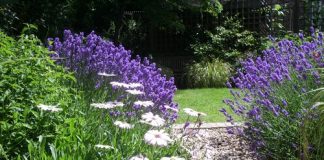Growing Peas – Peas (Pisum sativum) are one of the commonest and most loved garden vegetables, but they can be maddeningly difficult to grow because they are as popular with birds and mice as they are with humans. They can be difficult to germinate; they do not relish cold soils; and there is no point in sowing them early, particularly in a cold spring, for the mice will have more time to find them and the seeds are prey to fungus and bacterial diseases.
Conversely they are a cool weather crop and dislike open and hot positions in the garden. They will grow best in some dappled shade. If you want to grow early peas to mature at the end of May or beginning of June, you should protect the seeds with garden fleece or sow under cloches.

Growing peas
Peas can be divided into five groups: purple-podded peas (quite rare, but they look attractive in the garden and are well worth considering by the container gardener); mangetout or sugar snaps that are harvested young and the whole pod is cooked and eaten; the small, sweet petit pois; and ordinary garden peas that are shelled (there are two sorts: the sweeter, wrinkle-seeded varieties and the hardier, round-seeded varieties). Finally, there are the semi-leafless peas that were originally developed for commercial growers.

Peas will need support as soon as the first tendrils appear. This was traditionally achieved using pea sticks, cut from the hedges. Wide-mesh wire or nylon netting will serve just as well. Peas must be planted in fertile soil to flourish, but thereafter they do not need feeding. They do require watering when they start to flower.
Peas can be grown successfully in containers and should be grown as a feature plant in pots up a decorative trellis. If you plan to do this, check the height of the variety you choose before planting: this can vary from 45 cm-1.5 m (1 ½-5 ft). If your patio or roof garden is exposed they may require shelter, both from the wind and the birds.

Once the peas start to ripen they should be picked continuously as this encourages the plants to produce more and any surplus can be frozen. Ripe peas should be cooked immediately after picking as the sugar starts to turn into starch once the pod has been picked.
Sowing: Sow seeds in spring through to early summer.
Planting depth: 5 cm (2 in).
Planting distance: 7.5 cm (3 in).

Purple-podded peas
Soil: Peas like very fertile soil and will require regular feeding and watering.
Site: Cool. They will not do well on a hot, exposed south-facing terrace.
Harvesting: Ready to harvest after approximately 8 weeks.
Uses: Culinary.
Other varieties: ‘Kelvedon Wonder’, , ‘Early Onward’ (First Earlies), ‘Onward’ (Second Early), ‘Senator’ (Maincrop), ‘Oregon Sugar Pod’, ‘Sugar Snap’ (Mangetout).

Sowing peas

‘Kelvedon Wonder’

‘Oregon Sugar Pod’






































